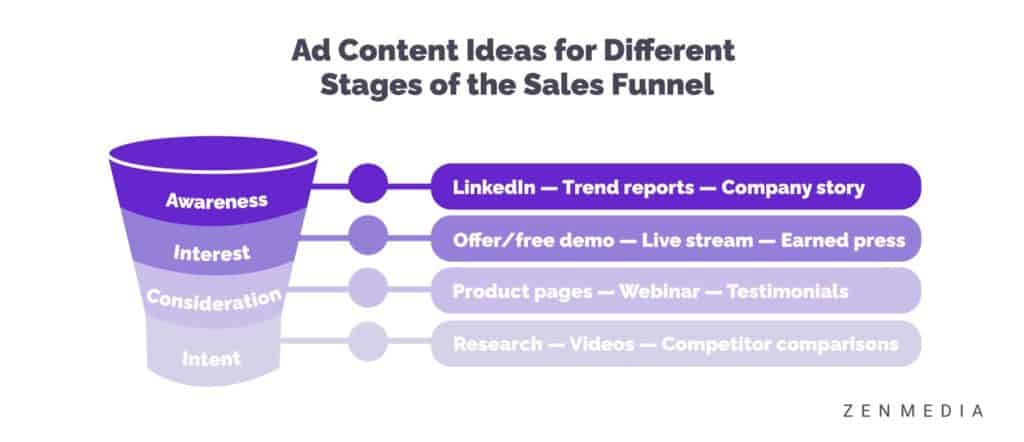There’s a place where buyers and potential customers can go where their clicks can’t be tracked. They can make buying decisions without any influence, and they can poke around without tracking or attribution software watching them.
It’s called the dark funnel—and at Zen, we call this the messy middle.
The “messy middle” is that part of the sales funnel that is hard to quantify and includes getting to those 27 touchpoints, talking with peers via dark social, pursuing content in untraceable ways, etc.
Individuals “funnel” through Google when they’re ready to buy something—and there’s no tracking on the things that got them there in the first place.
Essentially, it means many missed opportunities for B2B businesses and marketers. It includes important intel from sources such as industry publications, blogs, social networks, product review sites, and more—and revenue teams typically can’t access it.
But out of sight isn’t out of mind.
And if you know how to engage your audience—you can actually make dark funnel marketing work for you.
The Sales Funnel Has Changed—Here’s How
Sales funnels have become more demanding due to the increase in digital channels. B2B companies are facing similar expectations and challenges as those that sell to consumers, with 82% of business buyers now wanting the same experience as when they buy for themselves and 79% saying it’s easier than ever to take their business elsewhere.
There are increasing demands, and sales and marketing teams need to adapt and work more closely together. In essence, that’s changing the sales funnel—for the better.
Sure, marketing teams still hand leads to sales at a point in the funnel, but they have to stay involved in order to maximize customer retention and advocacy. The sales team can provide benefits of their customer knowledge early on to help increase qualified leads and conversions, and thanks to new tools, the messy middle can become not so messy.

Analytics are Essential
In the last 20 years, probably the biggest change to the funnel has to do with the availability and use of data. According to Salesforce’s ” State of Sales ” report, analytics and sales reporting top the list of technologies used, and 84% of sales ops professionals say digital transformation has accelerated since 2019.
According to the State of Marketing Salesforce Research, a majority of high-performing sales organizations (57%) are using AI technology to improve internal processes and customer experiences. And rather than spending two-thirds of their time doing data entry, sales reps now have that time back to focus on the messy middle and that dark funnel that’s often ignored.
Data insights are changing how sales and marketing teams make decisions. Sales reps now rely less on intuition in pursuing opportunities. Data analysis of “propensity to buy” is now the most popular method of prioritizing leads—in fact, it’s twice as popular as intuition.
Managing the Messy Middle
When it all comes down to it, in order to manage the messy middle, your sales funnel strategy has to be reassessed from time to time and updated to reflect changes. Your sales funnel needs to be constantly optimized to ensure sales journeys aren’t either too rushed or too long.
You can optimize your use of resources by improving the efficiency of your sales and marketing teams.
Data insights are the key. While three other data-driven technologies follow analytics and sales reporting as the most popular tools for sales (account and contact management at 65%, sales forecasting tools at 56%, and CRM systems at 58%), CRM systems are particularly crucial for optimization. You’ll be able to enable your business to organize all customer-related data in a central location—and, essentially, make your messy middle substantially less, err, messy. Your sales team can use data to better understand your prospects, and three-quarters of salespeople say data on prospects helps them prioritize leads and opportunities.
Salespeople believe a combination of human skills and data-driven insights is needed to convert prospects into customers. In fact, the ability to listen is seen by 78% of those surveyed in the State of Sales Report as an important attribute needed for landing deals. But sales reps also have to demonstrate industry knowledge (74%), trustworthiness (74%), and knowledge of prospects’ business needs (73%). Other important factors—such as engaging the prospect at the right time (76%)—aren’t always possible without the aid of these data-driven tools.
Once you’ve researched data insights, you can start to make dark funnel marketing and the messy middle work for you. Here’s how.
Optimize Your Content
Each phase of the funnel is trackable when it happens in spaces you can control or monitor—but when most of the research is happening on channels that are not controlled by the company, you have to up your optimization efforts. But how?
A smart URL—a link that contains tracker parameters and analytics to capture data—can be added to your content and programmed to report specific data points based on the requirements your company is looking for.
How it works: when your website content is shared off-site using a smart URL, many systems will cookie that user, so if the data is connected to your marketing automation platform, then you can potentially gain visibility into dark engagement.
Related reading: The Role of Content Marketing in the B2B Buyer Journey
Urchin Tracking Modules, or UTMs, are another way to increase your optimization. Essentially they’re snippets of code attached to the end of a URL and can be used to pinpoint specific sources of traffic to a website. It helps to know how traffic is coming to your site, and UTM codes will help collect the data and present it more easily.
Bring the Content to Your Audience
The majority of visitors to your website—a whopping 98%—are anonymous when they arrive. That’s a lot of missed opportunities.
But unless you’re actually identifying the source of that anonymous traffic, there’s a strong possibility that a lot of the buyer journeys that you would like to know about are actually happening right under your nose. Now you just need to learn how to capitalize on those dark journeys.
Your organization’s marketing activities are responsible for bringing those anonymous visitors to you, meaning you’ve already paid to engage those buyer journeys. But in order to reach the point of sale, you need to illuminate that part of your “dark sales funnel” to capitalize on those investments. The best way to do this is by bringing content to your audience.
While consumers are doing a lot of the legwork in researching a product or service, this translates to a higher level of engagement. And by bringing the content to your audience—via things like podcasts, word of mouth, PR, and events—you’re essentially “unmasking” the funnel.
But how do you keep them engaged long enough to make a decision?
Get an SME (Subject Matter Expert)
This may seem obvious, but getting a subject-matter expert—an SME—will help you engage with the audience you didn’t know you had. About 84% of C-level and VP-level buyers use social media for purchasing, and overall, 75% of B2B buyers consult social media when making purchasing decisions.
And your executives would be ideal candidates as SMEs. Whether it’s a CEO, a CMO, or an industry insider in a senior position, these colleagues can speak to other C-level and VP-level buyers organically. And if you don’t have an internal SME that is able and willing to engage, this is a good time to consider working with an influencer who is an SME in your industry, and will speak positively about your company and offerings.
Related reading: 10 Criteria You Should Look At When Identifying Influencers For B2B
Having an SME create your content can lead to deeper, more authentic connections with your customers—and when your marketing is customer-centric, it’s more likely to be highly effective in both the short and long term.
Create content that your audience will find helpful. This not only builds and increases your brand’s awareness but also helps you create a community around your business. When you build this community, focus on helping people first before thinking about profits.
Focus on Customers, Not Competitors
A lot of B2B businesses think they have to focus on what their competitors are doing and how to outshine their competitors’ efforts to reach buyers.
But they’re wrong.
When you anticipate and focus on the buyer’s needs and learn to interpret customer signals, it’s a win-win for your company.
What is the customer looking to do exactly? Exploring the intent signals allows you to identify customers earlier in the buying journey, way ahead of your competitors. After all, it’s not about knowing where your customers are in their journey—it’s about understanding why they’re there.
Once you understand why people visit your website, listen to your podcast, or read one of your blogs, you can potentially develop much more effective strategies to play to their deeper motivations down the line.
Related reading: Dark Social: What It Is, How to Track It, and Why It Matters for B2B
Be Consistent
Let’s be honest here: Greater insights are better than guesswork. And when it comes to B2B marketing, dark funnel marketing can not only shorten your funnel—it can also help you create brand awareness, drive differentiation, create demand, and increase conversion rates. The easiest way to do that: be consistent.
If you’re using your SME to drive organic social and blog content, make sure they post regularly. The key here is to not only be consistent with how often you post but also with your voice and messaging. Followers will get to know the voice of the SME and, by extension, the company—and that familiarity will help build trust and brand awareness.
While these extra insights into customer behaviors can help you make more effective decisions when it comes to strategy, messaging, and content creation, embracing dark funnel marketing isn’t easy. It requires taking a leap of faith.
Ready to take the jump? Reach out, and we’ll help you dip your toe in. The results will speak for themselves.





